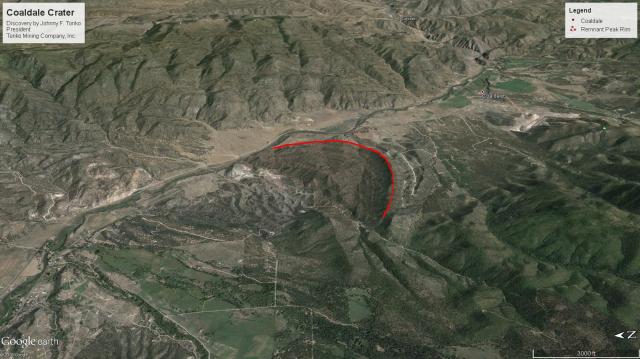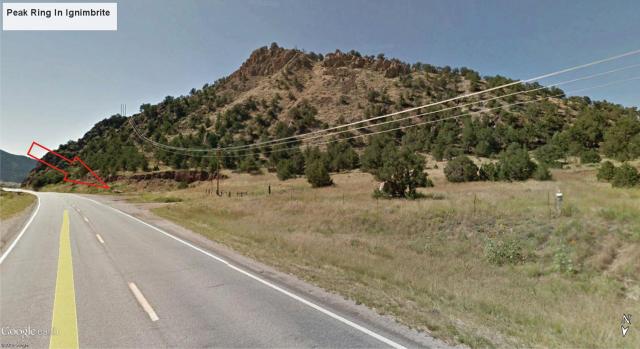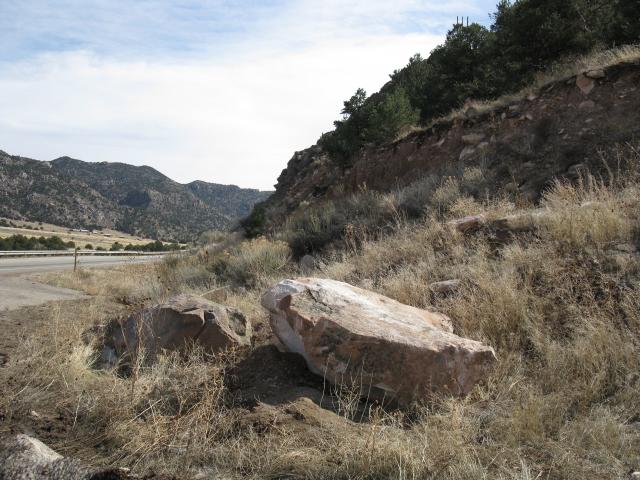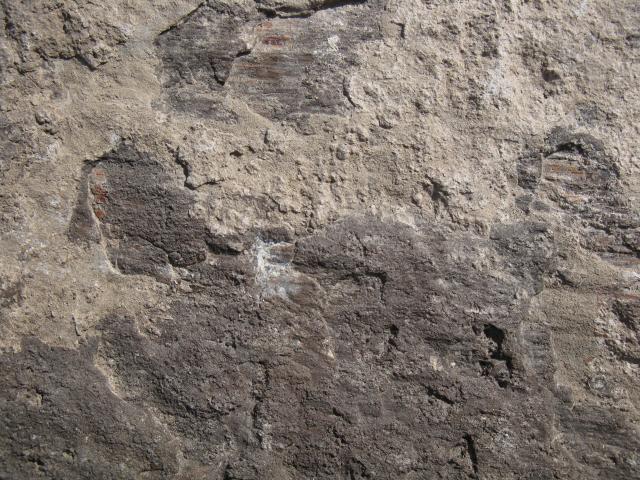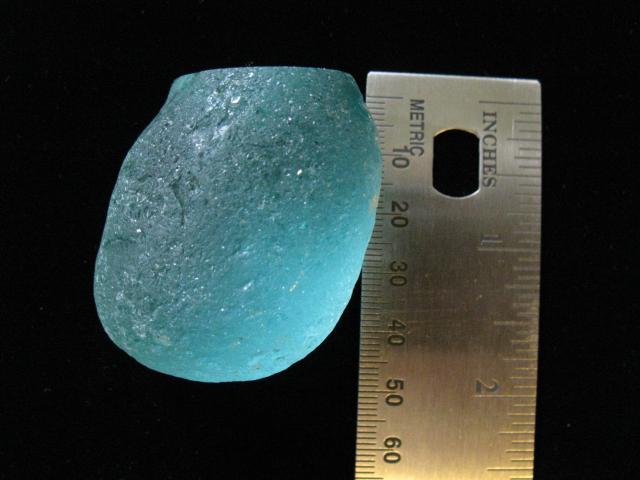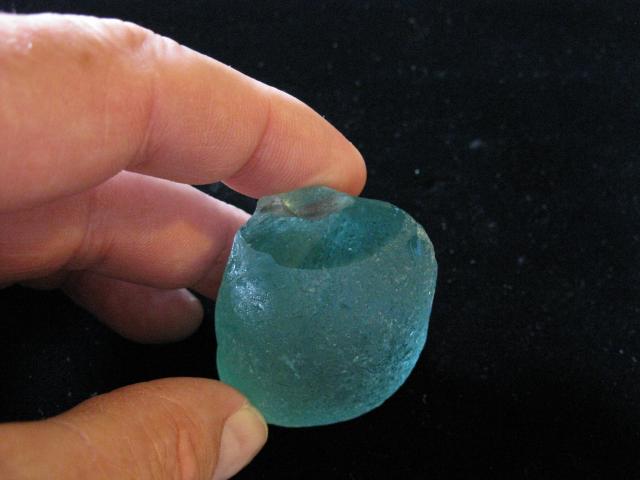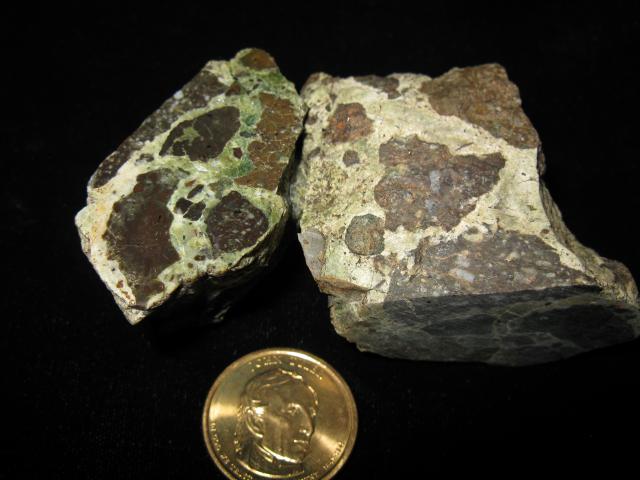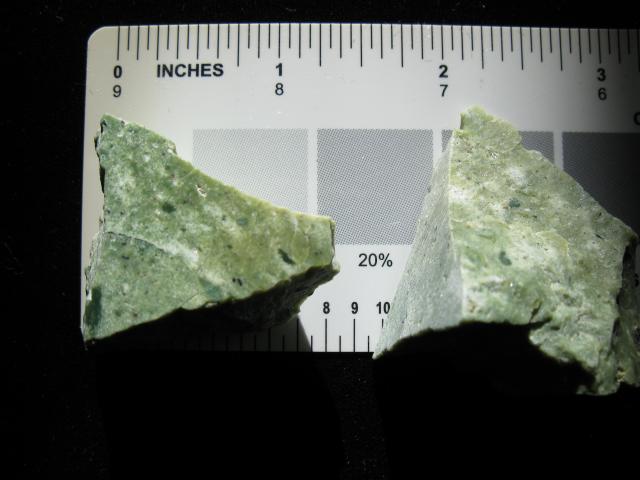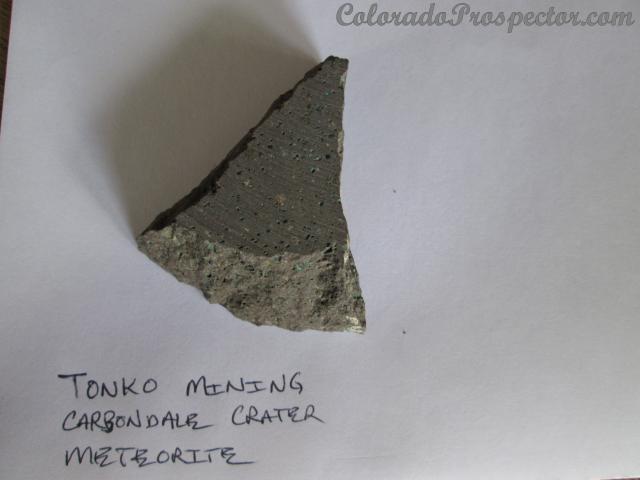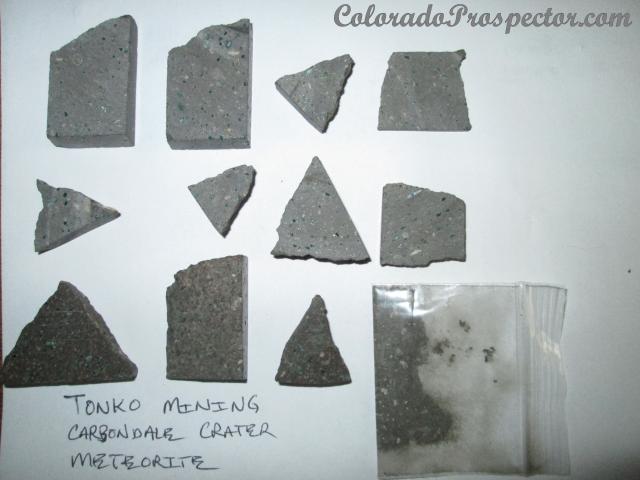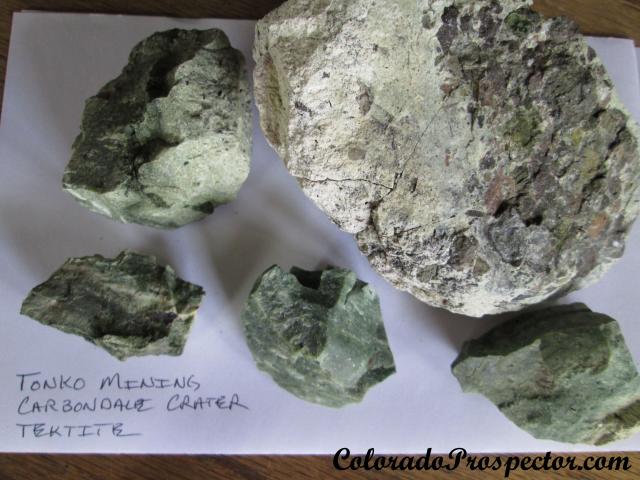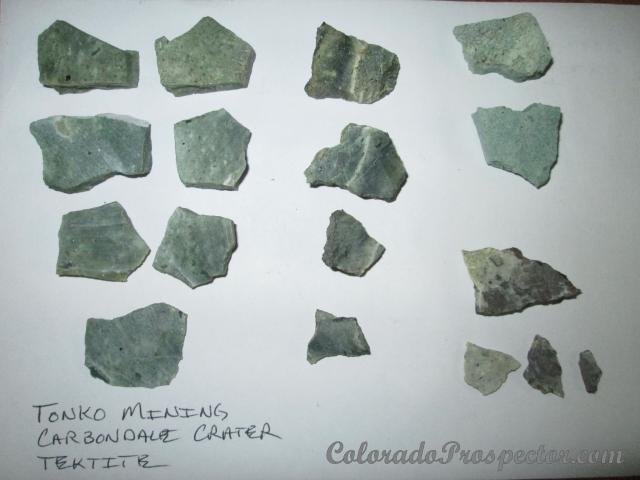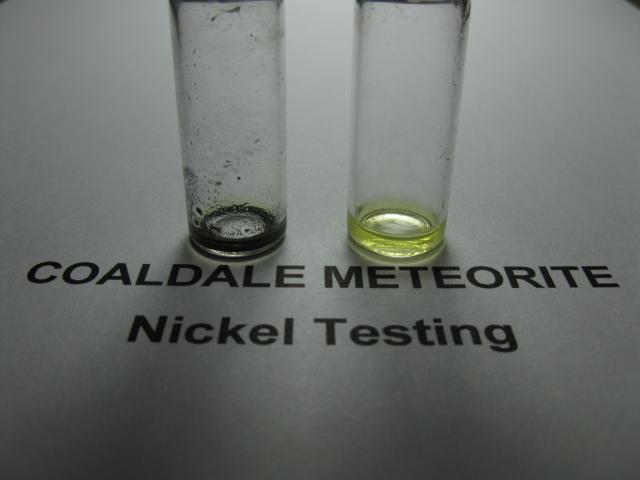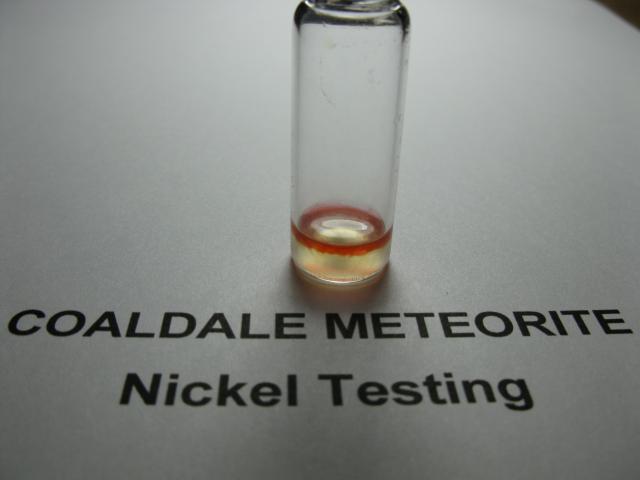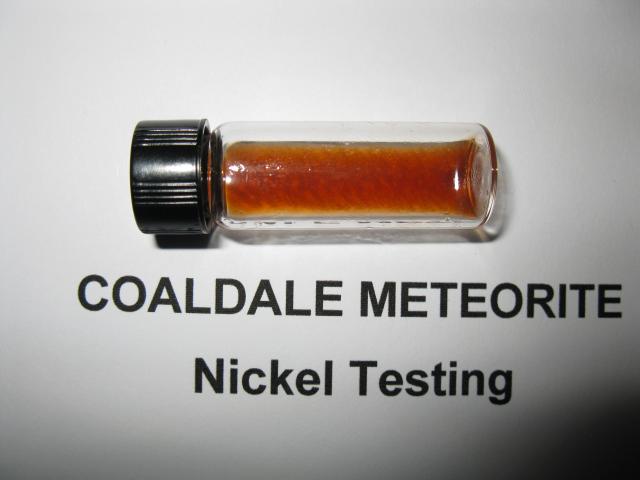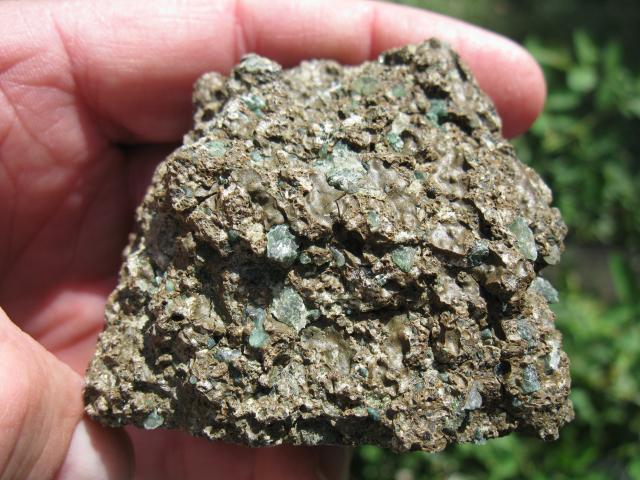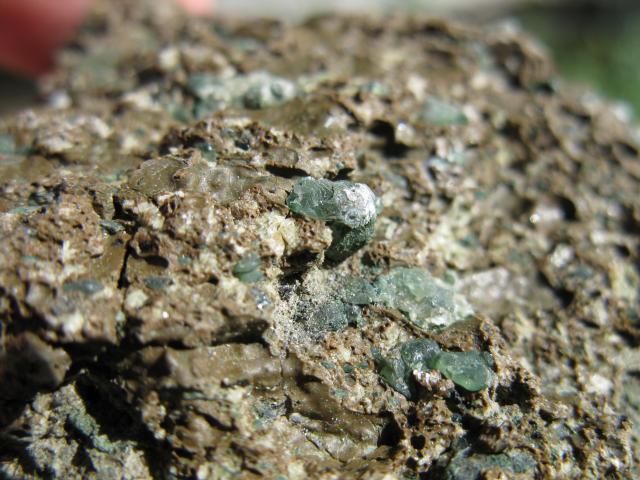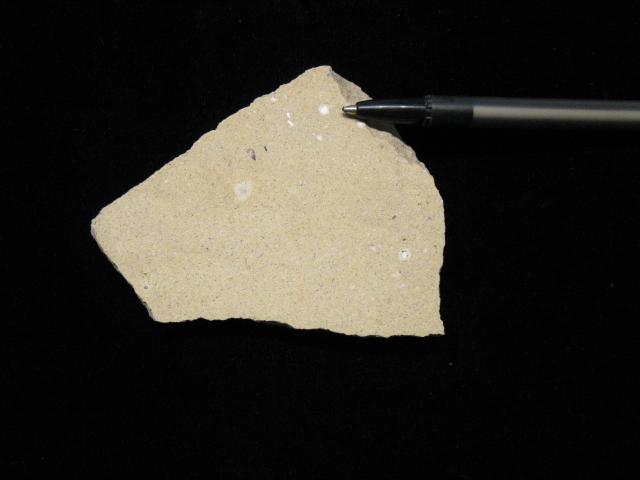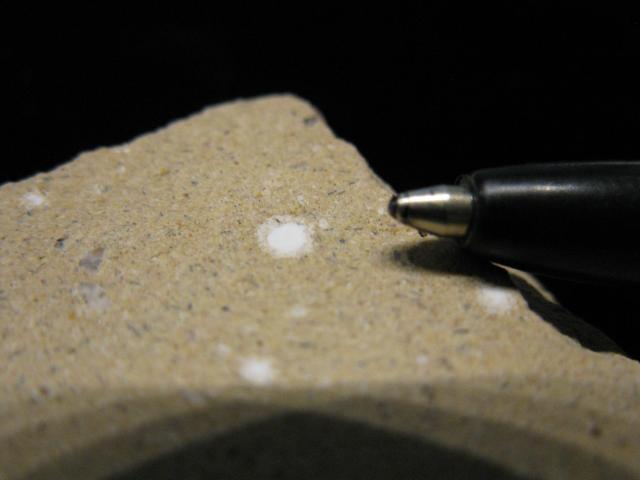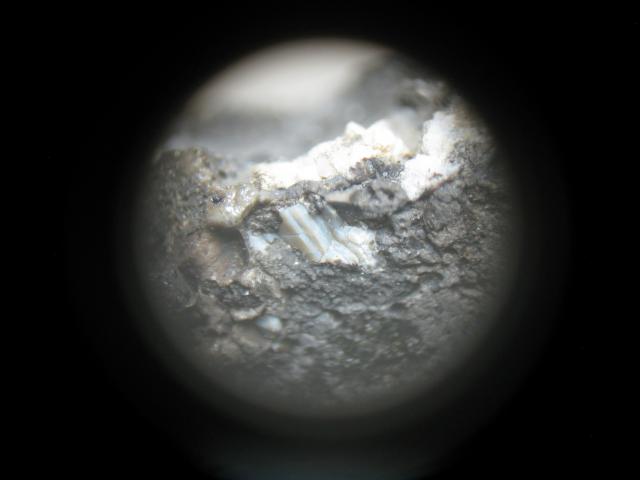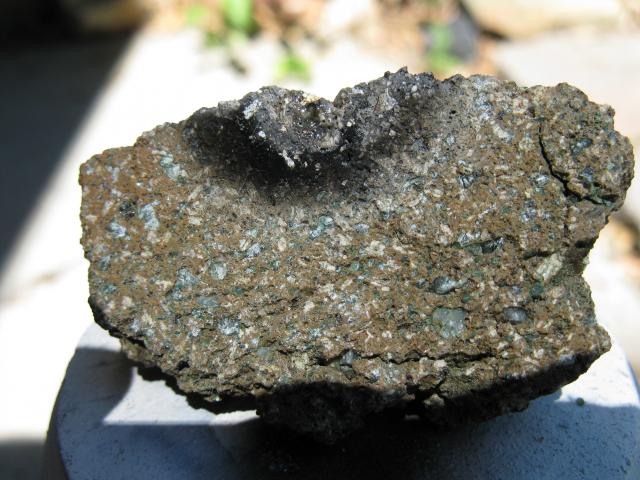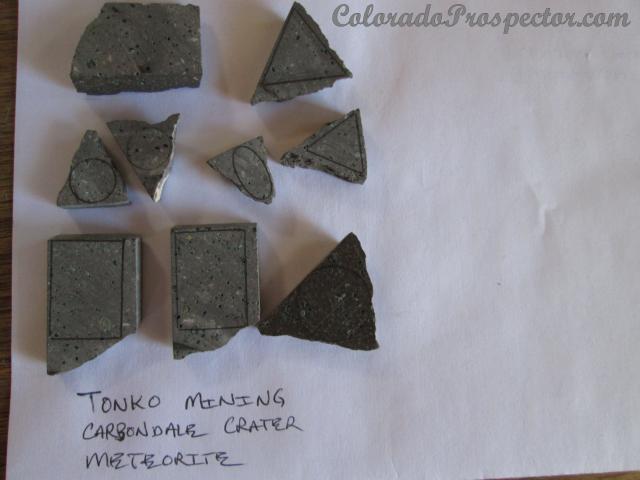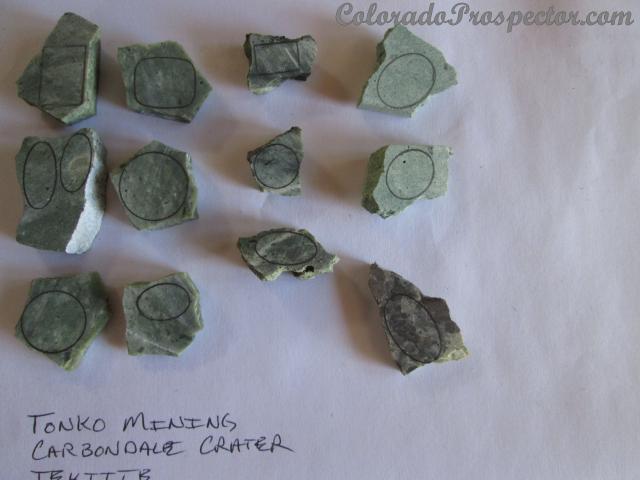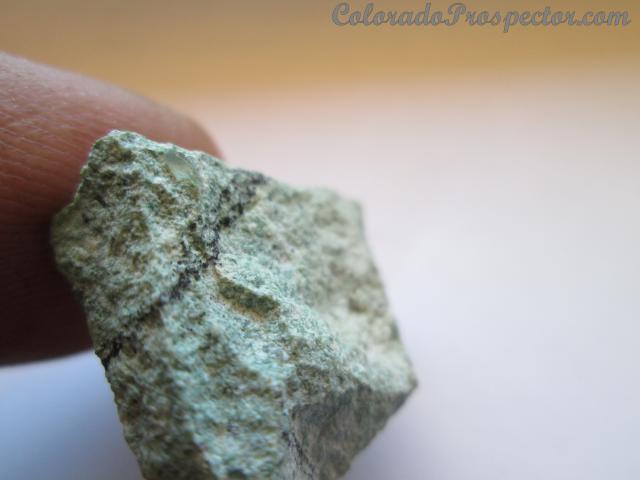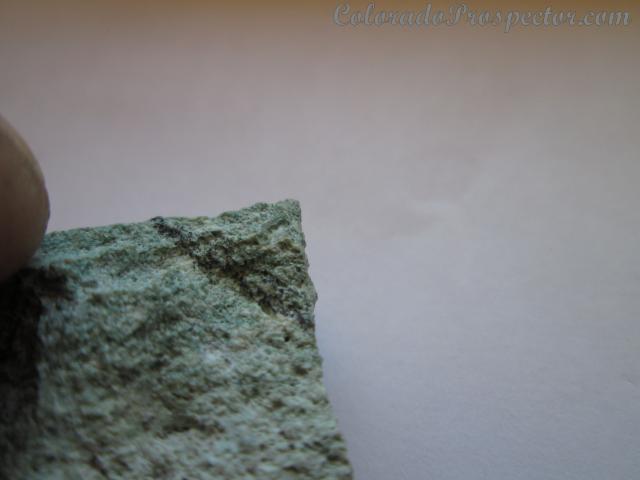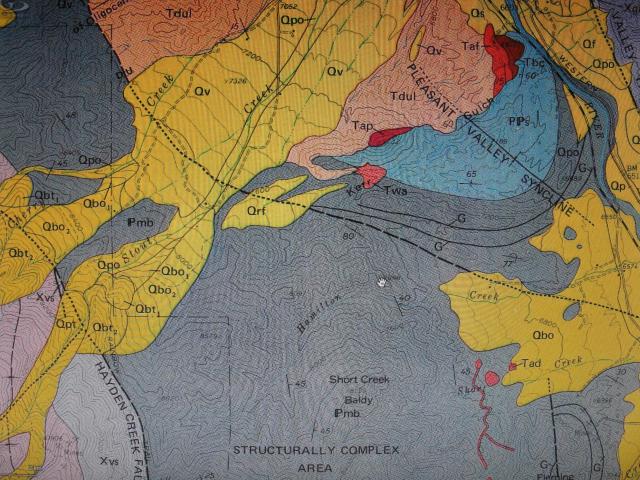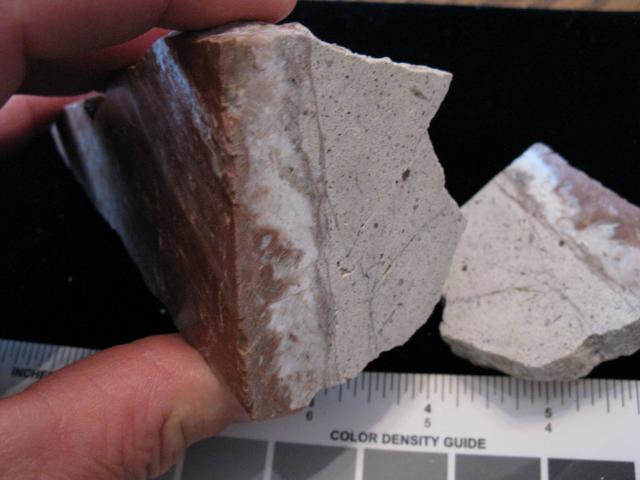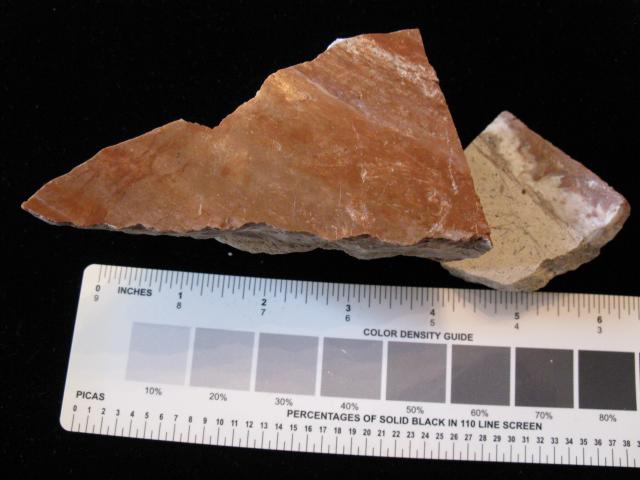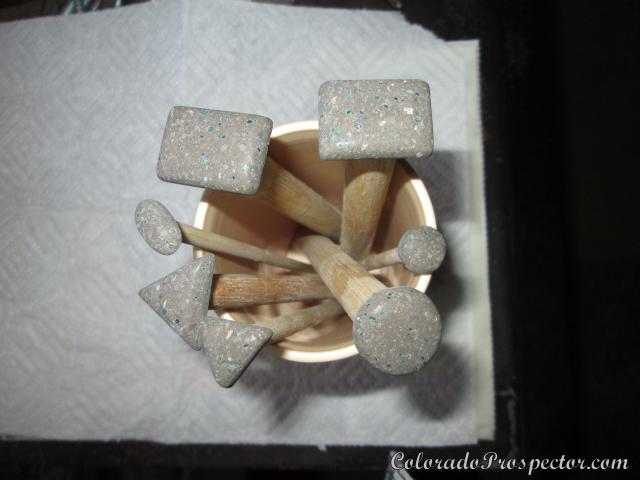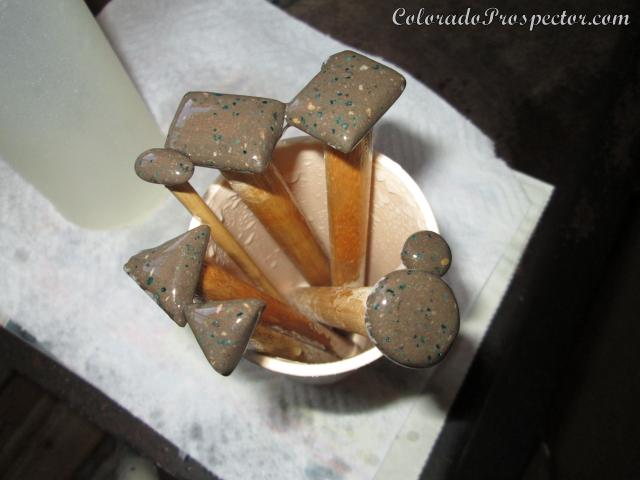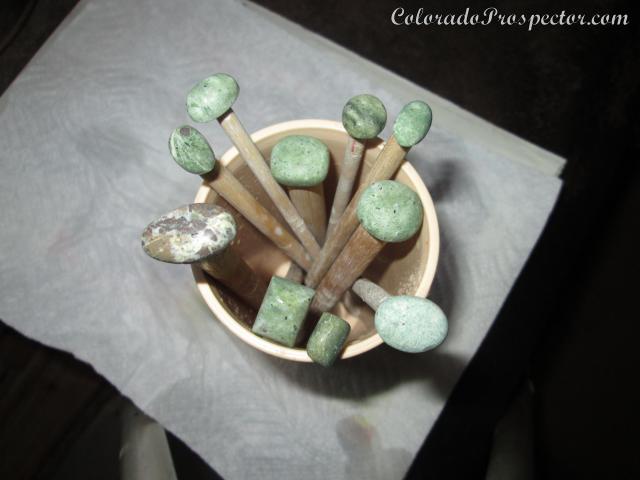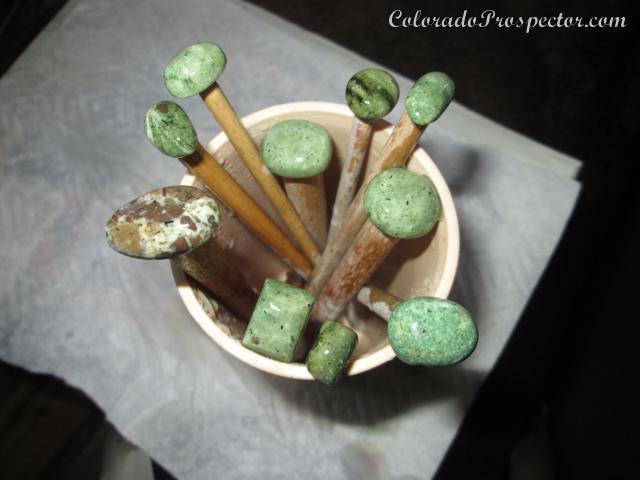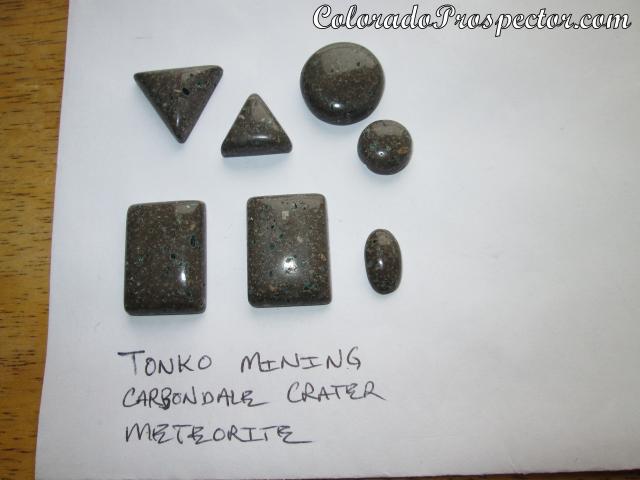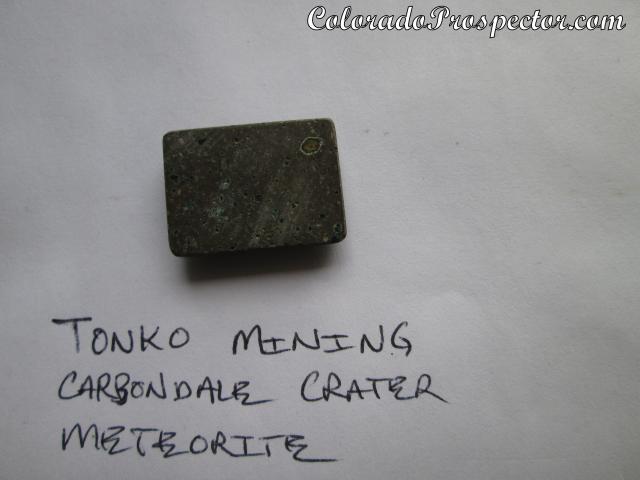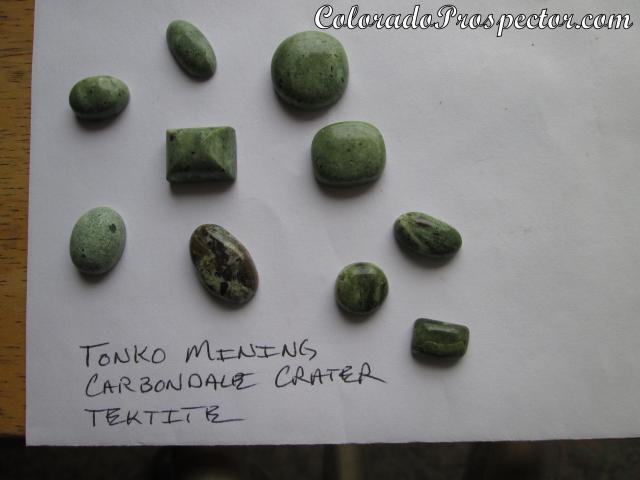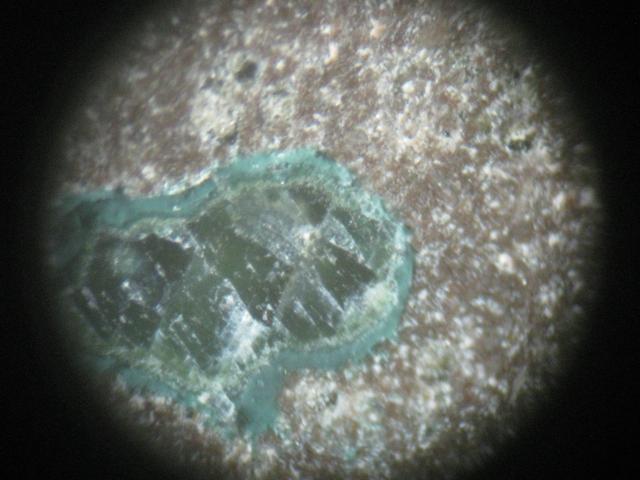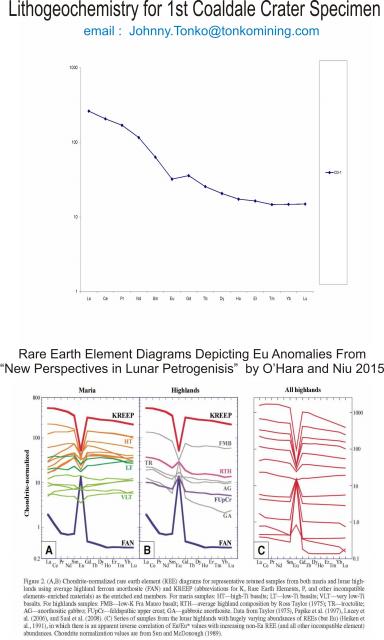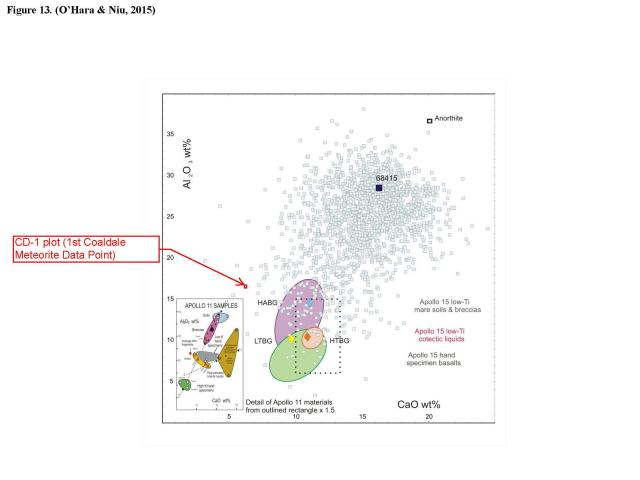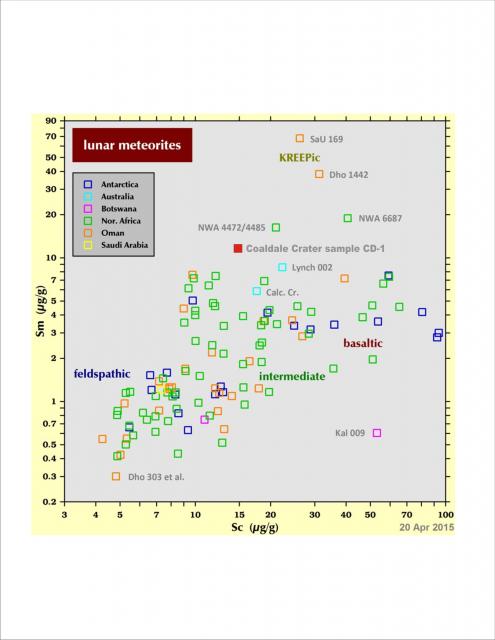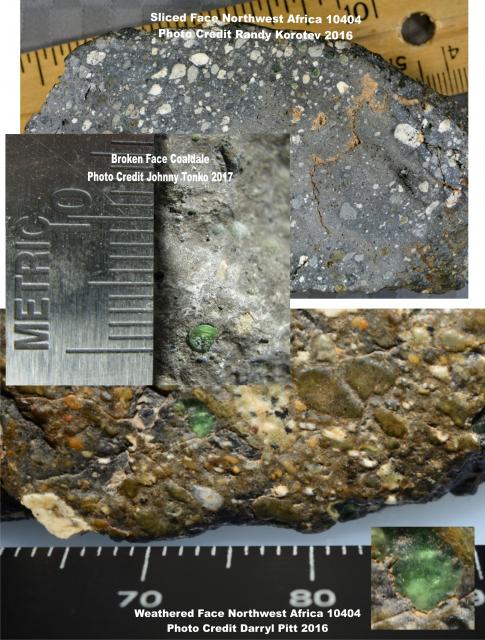Printable Version of Topic
Click here to view this topic in its original format
Colorado Prospector - Gem and mineral prospecting and mining forums _ Gem and Mineral Specimen Finds or Processes _ Coaldale Crater Gemstones
Posted by: ASTROBLEME Aug 3 2016, 04:39 PM
Members and Guests of Colorado Prospector,
Many years ago I discovered a highly eroded, geologically complex and very ancient impact crater centered 3 ¼ miles northwest of Coaldale, Colorado (USA). I am announcing this discovery as a long-time contributor to this forum in an effort to assure that the public has access to this information. Dan (the owner and operator of Colorado Prospector) is preparing some of my "Coaldale Crater" specimens for jewelry settings. He has graciously agreed to document his work progress so that others can gain a better understanding of the effort it takes to transform these raw materials into valuable gemstones. Please take time to follow this project along the way. I hope you find the subject interesting.
I'll be sharing the science behind this amazing discovery as our work progresses. This research builds upon my work at Gunnison Crater, Westcliffe Crater, Silver Cliff Crater and Hillside Crater that proved an extension to the 38th Parallel Crater Chain dating to the Late Devonian Period. Although the Coaldale Crater is also along the 38th Parallel, it is not part of the well documented crater chain system. My efforts in the Coaldale Colorado region included collecting field survey data, acquiring and analyzing numerous geologic specimens followed by an extensive review of the relevant scientific literature. The results support an impact event that occurred during the Oligocene Epoch.
For now, I'm providing the attached map depicting the present peak ring exposure. It is fascinating that this impact crater has survived the deep erosion and strong fault deformation that Mother Nature has provided continually over the past 27+ million years.
Sincerely,
ASTROBLEME
Posted by: Woody Aug 4 2016, 08:31 AM
Interesting indeed,
I pass by there frequently and never thought a thing about impact craters. I'll be there today working about 5 miles off the HWY. Certainly going to give it a second look this time. Thanks, Woody.
Posted by: Denise Aug 4 2016, 10:46 AM
![]() Thats amazing information you have provided Johnny!! Thank you VERY much for sharing this info with us and the forum users!!
Thats amazing information you have provided Johnny!! Thank you VERY much for sharing this info with us and the forum users!!
Colorado Prospector would be more than honored to work those amazing specimens for you. ![]()
Posted by: ASTROBLEME Aug 4 2016, 10:57 AM
Hello Woody,
As you pass the area on Highway 50, take notice of the conspicuous hill near the Kerr Gulch Road. If you pull off the highway into that wide area depicted by the red arrow in the Google Street View below, you'll see a large boulder. This rock is an ignimbrite named Fish Canyon Tuff that eroded from the hillside. Before it came to the present day resting place alongside the highway, it was erupted from the La Garita Caldera in the San Juan volcanic field about 27.83 million years ago. This ash flow rock (along with numerous other rocks within that peak ring exposure) shows slickensides with strike-slip striae... strong evidence of impact induced shock. Photos of the rock and slickensides are also attached.
ASTROBLEME
I pass by there frequently and never thought a thing about impact craters. I'll be there today working about 5 miles off the HWY. Certainly going to give it a second look this time. Thanks, Woody.
Posted by: ASTROBLEME Aug 5 2016, 09:18 AM
History of Impact Crater Discovery
John Tonko (my father) was fishing the Arkansas River a half-century ago just downstream from what I now recognize as the Coaldale Crater. He saw a glimmer of light coming from the wet black sands along the shoreline. Digging out the sparkling object, he thought at first it was just a piece of antique glass insulator. Closer examination showed that it was something very special. The specimen was subsequently examined by college faculty, gemologists, and geological laboratories. Their general opinion was that the gemstone was an exotic specimen of unknown origin.
John Tonko (my grandfather) came to America from Austria to first mine coal in Pennsylvania and a few years later he moved into Colorado to mine hard rock gold. That long family history is likely why I have such passion for prospecting. I remember my father's excitement that day of his find. He had never came across such a specimen in all of his life. Eventually he wanted to learn more about his find, so he had a "window" cut into the gemstone in the mid 1970's. That work was performed in order to reveal the interior that was hidden from view by the surface erosion pits created by the river currents. The gem cutter was surprised at the hardness of the specimen. There was some loss due to the cutting and polishing so the historic gem currently weighs in at 369 carats. The attached photos are of that historical blue-green gemstone my father found when I was just a boy. Now, through lots of time, substantial effort and personal expense, I have the good science that supports the source of that gem as being from the meteorite that created the Coaldale Crater some 27+ million years ago.
ASTROBLEME
Posted by: ASTROBLEME Aug 5 2016, 03:46 PM
Gemstone Material Represented in Breccia at Coaldale Crater
The attached photo depicts the major stratigraphic complexes and regional ignimbrites trapped in impact generated breccia. As a side note, the coin used for scale was found in a recent recovery of a CP Geochache. ![]()
A close observation of this cut specimen reveals the blue-green gemstone material from the meteorite along with shocked quartz fragments. The other major components and age in millions of years are as follows;
Carpenter Ridge Tuff 27.4 Ma
Fish Canyon Tuff 27.8 Ma
East Gulch Tuff 33.7 Ma
Antero Formation 33.8 Ma
Wall Mountain Tuff 36.7 Ma
ASTROBLEME
Posted by: ASTROBLEME Aug 5 2016, 04:33 PM
Geochronological Data
The impact into the paleovalley creating the Coaldale Crater has been precisely dated. Based on a published report for 40Ar/39Ar analysis of a thin greenish-white deposit preserved within the crater's remaining peak rings, impact is dated at 27.38 million years ago. The data is of very high percision and has a deviation of only plus or minus 0.12 million years.
The greenish gemstone material sourced from the meteorite that smashed into the valley is clearly visible in the attached photo of the fall back breccia deposit. A similar type rock is now being crafted by CP and I'm anticipating some great looking gemstones. ![]()
ASTROBLEME
Posted by: CP Aug 6 2016, 03:38 PM
Very cool information Johnny and thank you very much for posting your discovery announcement via the forums here! We will be looking forward to more updates on your work through the years to prove up this craters existence too, just fascinating! Obviously since that killer gem piece was found by your dad years ago..... (GOTTA' SAY WHOA AND WOW TO THAT! ![]()
![]() ).....that is a sweet rock!
).....that is a sweet rock! ![]() So that would be a "chondrite" nodule? If I'm understanding it right?
So that would be a "chondrite" nodule? If I'm understanding it right?
You've had an interest in meteorites, craters and mining in general since a very young age. Bet you've had a lot of time vested in research and a whole heap of info to go with it over the years. Going to be fun watching this thread and project progress for sure! Stay tuned folks if you like this kinda' science stuff.
I'd also like to take one moment to mention that Johnny here happens to be our longest running yearly club member thus far. That says a lot to me and the rest of the club I think it is worth a mention. Thank you Johnny! ![]()
So, Johnny and his wife Donna drove down to bring some samples/pieces to cut for this project. I'm very pleased and proud to work some more material for Johnny on this project and it was great to finally get to meet them both after all this time too! We had a great visit and they brought several samples to work with for this project as well as a couple other samples I'll also be making projects out of later....... Those are not from this crater or included here though.
For now I'll be working on a cut lot of the Carbondale Crater Meteorite sample provided and tektite samples provided. The one meteorite sample we'll begin with for the cuts. First is a pic of the rough meteorite sample.
Since this is also a project to help the further study of this material, I also took some extra time before cutting to brush clean out the saw used. So after cleaning out any other material/dust from previous cuts in the water box area under the saw, I cut the meteorite first which produced these cuts in the pic below....... The idea behind the pre-cleaning of the water box container was to reclaim what the saw cuts out of the meteorite sample....ie small chondrite nodules. So in the small bag lower right is the reclaimed saw cuttings for Johnny's further study purposes as well as two very thin slices middle right and upper right also for study purposes. One is about 1 mm thick the other approx. 2 mm. and that is done free handed on a small saw with a thick/stiff blade. Other cutters may have used a thinner more flexible blade for less loss during cutting, but I feel the opposite with that thought for anything over 3/8" thick....I think a flexible blade causes more waste actually with the uneven cutting that occurs (especially trying to slice or slab) which then must be ground flat anyway. All these pieces are flat enough to be blank fronts of the stones to be cut, or back sides without further grinding or waste of material. More consistent cuts equal no waste!
All the other nine pieces in this pic could be used to cut a stone I think, time will tell, the meteorite sample was solid and cut well! The lower left piece was part of the original surface that Johnny hand polished previously and shows how the finish cut/polish will look darker than the slices cut now do.
There are several (a bunch) tektite samples provide to work with of which I sorted into 4 types so to speak...... Unfortunately all the tektite material is highly prone to cracking and with some effort through several samples I did manage to get a few workable slices. The types of material are all represented in this pic of rough samples. A conglomerate (upper right), a very light green(upper left), a range of medium greens (lower right and center), and a few very dark green with white banding (lower left).
After cutting I've culled out these pieces as possible to work......the conglomerate had the worst fracture problem and there is only 1 viable slice so far for that (lower right with 3 thin study slices), next worst with the fracturing was the lightest green material (upper right) which may not stay together well enough to endure cutting/cabbing process. The middle row (up/down) is of the darkest green with white banding, I think it will cut nicely but still a fracture concern, top piece of that row shows rough side, with two under showing cut sides and one thin study slice at the bottom of that row. Far left group is of the medium green types and showed best for less fracturing but still does have them. Top piece shows a rough side, the rest show cuts and of course one thin slice at the bottom for study purposes. These have many inclusions that should be very pretty when polished out to finish.
More updates to follow folks, this is going to be a fun thread and project!
Posted by: ASTROBLEME Aug 6 2016, 07:05 PM
Dan,
I am so impressed by your ability to cut those thin sections. ![]() Your efforts will help with investigating the chondrules further. Many thanks for preparing those slices.
Your efforts will help with investigating the chondrules further. Many thanks for preparing those slices.
Members and Guests,
The majority of chondrules in the Coaldale Meteorite are similar to other meteorites but those thin rimmed, blue-green hued, glassy chondrules are distinctly different. The spherical inclusions are not to be confused with a secondary infilling process that occurs in some volcanic deposits. Only a handful of meteorites in current collections have any "glassy" chondrules. These unique blue-green glass rich chondrules are the source for my father's gemstone find. Of significant interest is the fact that I've found a limited number of cavities that I call "sockets" in some broken fragments of the Coaldale Meteorite. A few "sockets" are quite large...and I interpret those cavities to be the source of the exotic gemstones such as my dad's...and with deposits found in the Red Rock Placer Mining Claim Group that I've located on the Arkansas River where it cuts through the crater.
The tektite and breccias at Coaldale Crater that Dan is preparing are basically a hyper-velocity impact melt induced reworking of the meteorite, mixing it into the deposits that were in place at the impact crater site some 27+ million years ago. Most of the meteorite was destroyed and the glassy chondrules in the meteorite were remelted and mixed up with earth material being excavated during the crater formation. The common name for this type of impact material is "tektite". Dan previously worked up the Gunnison Crater Tektite gemstones for my company several years ago. In fact, he was the first one who recognized metal inclusions within that tektite. I fully trust his ability to work on this project. ![]() I think Coaldale Tektite will have fantastic eye appeal and I'm looking forward to the shaped and polished results!
I think Coaldale Tektite will have fantastic eye appeal and I'm looking forward to the shaped and polished results! ![]()
It is apparent that the meteorite creating Coaldale Crater was a large object that had coalesced from collisions in space with other bodies. Those high speed space collisions resulted in melting of the original meteorite's components to form the larger body having a much altered composition in the end. The rims of the glassy chondrules appear to contain mineral and glass compositions from the original nebular condensation components and tiny matrix grains of the smaller original meteorite(s) that had coalesced. Only recently have scientists started to investigate this type of chondrule formation. Experiments using NASA’s two-stage light gas gun to analyze thermal and shock alteration due to hypervelocity impacts into variable materials is currently underway.
I am still months away from finalizing the all data from this meteorite impact. One thing that might interest readers of this thread is the results of the chemical test I developed for fast and cheap determination for “meteorite or meteor wrong”. You can read about the procedure on this forum at
http://www.coloradoprospector.com/forums/index.php?showtopic=5032
The attached photos show the results for that nickel test on the Coaldale Meteorite specimen.
ASTROBLEME
Acid Leaching Result
Addition of Nickel Test Reagent
Final Result
Posted by: ASTROBLEME Aug 7 2016, 05:43 PM
Shock Melt Evidence
Hello Everyone,
In an effort to help with the understanding of the almost instantaneous changes that a high speed space rock goes through when it impacts into another high speed space rock, I'm attaching 2 photos of an altered fragment of the Coaldale Meteorite. Before it arrived at the crater site, this piece was subjected to intense heat and pressure induced by impact(s) in space. The brownish colored matrix of the meteorite melted first. The last thing to succumb to shock melt metamorphism was the "blue-green glassy chondrules". So if you look closely at the pics, you will see all phases of the impact shock melt process in this piece. Some glassy chondrules still show strong shock evidence in parallel lines. Others show conchoidal fracturing. Some of these blue-green glassy chondrules are significantly melted and match characteristics of my father's find. All these phases of shock induced melting are easily observable by the naked eye within this single specimen of altered Coaldale Meteorite. These alterations happened in the cold dark reaches of space and the impacting objects coalesced into some thing brand new. All this happened before the newly formed object impacted Earth...or as I prefer to say...the Earth smashed into it. ![]()
This is the first recovered specimen that proved to me that my father's stone was related to the Coaldale Crater Impact Crater. ![]() The glassy chondrules are inside smooth cavities that I call "sockets". The larger the socket, the larger the gemstone.
The glassy chondrules are inside smooth cavities that I call "sockets". The larger the socket, the larger the gemstone.
I'll be attending this evenings club meeting at 6PM if you have any questions. If you're a member please attend, if you're no yet a member, please sign up and participate in this discussion.
ASTROBLEME
Shock Melt Coaldale Meteorite Fragment
Close up View Shock Melt Coaldale Meteorite Fragment
Posted by: CP Aug 7 2016, 05:55 PM
Very cool Johnny, and thank you kindly for the compliments! ![]() I'm looking forward to the discussion tonight.
I'm looking forward to the discussion tonight.
Also, while working on the cuttings today (assigning shapes to the blanks), I also noticed a large glassy something on the outer rough layer of one light green piece of tektite. I tried to snap a shot of the tiny (crystal?) but it's kind of little and hard to shoot a pic of.
It's almost meetin' time folks! ![]()
Posted by: EMac Aug 8 2016, 04:10 PM
Hi Johnny,
Thanks for sharing this info with us, and particularly for sticking your neck out! This is all new to me, and it's taking me some time to dig in and understand what you're saying. I've been doing a lot of reading about identifying meteorites and tektites compared to plain rocks and volcanic glass, and reading about the signatures associated with hyper velocity impacts. I'd like to respectfully challenge your finds with the understanding that at a very minimum I/we will come away with more education.
Have you published or attempted to publish any of your findings/theories in a peer reviewed journal? Frankly, this would gain you a lot of clout if you get other learned individuals to agree with your theories. It would seem that if you've found 3 previously unknown impact craters right here in CO that the geology community would be clamoring to know more. The Gunnison article from 10 years ago had two professors disagreeing with your theories around Gunnison, and now you have 2 additional crater theories. Barringer took 3 years from time he made his theories public in 1903 to when he provided documented evidence to the US Geologic Survey. It took at least another 47 years for the scientific community to get on board when Shoemaker confirmed Barringer's findings.
How do you know these are tektites and meteorite fragments? For instance the pictures below you say are meteorite fragments, but I see a lot of vesicles present which I understand to be indicative of terrestrial rocks. I understand there's also not much difference between tektites and obsidian, but we can determine which is which by exposing samples to an oxyacetylene torch (http://www.meteorite-times.com/jims-fragments/tektite-testing-revisited/). Do you have any tests like this? Are you able to share any reports on samples you have such as SEM-EDS? This would be quite interesting to see for the blue sample you have.
Quoting a report by https://www.psi.edu/sites/default/files/images/epo/explorecraters/Osinski-ESASP06.pdf,
With respect to what you call the Tonko lineament, you state the Gunnison crater occurred during the Devonian period and is part of other impacts along the 38th parallel. The Devonian period was ~363-409M years ago, followed by the formation and break up of Pangea 245M years ago, the Laramide Oregeny uplift 57M years ago, the clockwise rotation of the entire Colorado Plateau (includes Gunnison, but excludes Denver, and certainly Missouri and Illinois) 20M years ago, and additional uplift 5M years ago. That was followed by glaciation, erosion, periodic faulting and volcanism. It seems fairly obvious what's in a straight line today, certainly wasn't that way 350M years ago if we include Colorado in the 38th parallel lineament. How do you explain these differences? Assuming you can prove these are impact craters, why would you need to tie them to the 38th parallel lineament at all?
Additionally, on your website, you show a picture of Gunnison breccia next to Weinbleau-Osceola breccia showing the similarity. Since I had no idea what impact breccia looks like, I went looking. I can't help but notice they look similar to the bottom left breccia from Washington University's meteorite identification page (negative examples): http://meteorites.wustl.edu/ & http://meteorites.wustl.edu/id/z_breccias3.jpg. What differentiates the breccias you have?
Around the slickensides and strike slip faults below, I'm not sure that's an indicator of anything, so I'm hoping you can expand on your point here. You state it was ejected by volcanic forces ~28M years ago, and the ashflow shows slickensides in a strike-slip orientation (horizontal slippage). This period of time is also marked by significant geological activity, all of which can produce slickensides; how do you attribute slickensides observed with an impact event vs well known geological events from the same time period? I can't find that there's a correlation between slickensides and impact events, although it certainly seems feasible.
Again, thanks for taking the time to share what you've found with us! I know I've learned a lot just being exposed to the subject!
~Eric
Posted by: ASTROBLEME Aug 8 2016, 07:40 PM
Hello Eric,
Thanks for looking at this matter from a scientific perspective. I'll try and answer your inquiry.
Re: Coaldale Crater
First, lets cover the peer review question. I have been a member of the Impact Field Studies Group that traveled around researching impact craters. The group is no longer active as interest in these maters seems to follow funding and there isn't much available any more from public sources. Prior to retiring as a scientist/researcher from the Colorado Department of Natural Resources, I can assure you that I have completed much research and written numerous papers that were then reviewed at all sorts of levels including judicial review up to the Colorado State Supreme Court. For decades, my work was property of the government agency that employed me...not my own. The government controlled the data and results and I understood that process all too well. The thing that always bothered me most was if my findings did not square with the politics of the issue or it was contrary to what high level decision makers were trying to support or deny, then my work was never released publicly. This problem is systemic...you see it everyday when Freedom of Information Act Requests are made or Sunshine Laws are used to get required info from public sources. This is the same pattern seen in many scientific communities. Peer review papers are owned by the publisher and often, one must pay the publisher just to read them. My personal work product belongs to me. Therefore, I can share my research with those interested parties without limitations. It is for these reasons that I don't care to "gain a lot of clout if you get other learned individuals to agree with your theories" as you suggest.
As I noted in the posting of August 6th at 8:05, I advised readers that I'm am still months away from finalizing results from all the data I have collected from this structure at Coaldale. The FUS-ICP and INAA lab tests I have in-hand and all the others that I'm still in process of obtaining on Coaldale, along with continued lab work for samples from Gunnison, Hillside, Westcliffe and Silver Cliff Craters...well that is very expensive. Since I self-fund all this, it is going to take much more time until I've finished with this effort. Vesicles are not present in the Coaldale Meteorite. You might be seeing the pits from my cutting equipment in the pics of the meteorite. My saw is old and worn out, so it wobbles, shakes and tears out the chondrules leaving behind a spherical pit that resembles a vesicle. I think the fresh cuts that CP is doing do not show anything like vesicles in the meteorite specimen. He is more skilled at cutting than I and he has the proper equipment for the work he's performing. Keep in mind that ancient meteorites are very altered by weathering and they look nothing like modern meteorites that are in collections today.
Planar deformation features produced by shock are the features that are generally accepted as unequivocal evidence for hypervelocity impact. I have done that for each crater by use of a 60X stereo microscope to confirm their presence or absence in field samples. The slickensides indicate the direction the rock moved and the great number, intensity and direction of the slickensides at Coadale point towards a cratering event. Understanding the volcanic events provides further evidence of an impact event. The age sequence is inverse for the volcanic-stratigraphic succession at Coaldale Crater. Specifically, the 27 Ma ignimbrites are buried underneath 32 Ma strata. I saw this same overlaying of older strata on younger strata when I visited Canyon Diablo Crater in Arizona a few years ago. The impact process overturns and reworks whatever deposits are in place at time of impact. These inverse exposures at Coaldale Crater are strongly indicative of an impact event.
Re: Gunnison Crater
On my company website in the Gunnison Tektite offerings, I have given notice that it was tested in oxyacetylene flame to incandescent temps without melting. On the 38th Parallel alignment, there has been some movement but the area as a whole has shifted and the uplifting and erosion isn't significant enough to shift the lineament pattern. Your concern over the pics of impact breccia should be put to the side by the 2 attached photos of sliced and polished Gunnison Crater breccia. Please take notice of the white glassy spheres that are impact-generated carbonate accretionary lapilli that are prima facia evidence of a crater event. These are also identical to those observed in the breccia at Alamo Crater. Alamo Crater is in my Tonko Alignment along the 38th Parallel, being the furthest west and also dates as late Devonian.
I probably haven’t answered everything you asked but I gave it an honest try. Please understand that if it weren't for my efforts, then these structures would still be unnoticed.
ASTROBLEME
Posted by: EMac Aug 9 2016, 08:50 AM
Thanks Johnny; as expected, I've got more reading to do. ![]()
Posted by: ASTROBLEME Aug 9 2016, 02:21 PM
Flame Testing
Eric had questions about flame testing so I want to share these findings for Coaldale Crater Meteorite. I used an oxyacetylene torch to heat a very weathered specimen along the edge until it became incandescent. The specimen’s edge was kept in a white hot state for an extended time. The matrix melted somewhat but the glass remained intact... except for some shattering after it cooled. The attached 10X photo shows the slight melting of matrix but most importantly reveals that the shattering followed the shock lamellae in that blue-green glassy chondrule.
Here’s a link to a photo of shock lamellae in quartz from the K-T boundary. I think you’ll see the characteristics of planar deformation that is further proof of hypervelocity impact.
http://maps.unomaha.edu/maher/GEOL3300/week11/shocklamallae.jpg
ASTROBLEME
Posted by: EMac Aug 9 2016, 05:05 PM
Do you have any macro pictures of the test? It doesn't appear in your pic that the sample has been heated/melted.
The test I saw, he blasted large portions of the samples. The ones showing any froth weren't tektite, compared to the known tektite control sample on the far right:
The test is also described here along with other criteria: http://tektitesource.com/Tektite_tests.html
Documented tests of known tektite and suspected obsidian: http://www.tektites.co.uk/tektite-tests.html
Posted by: ASTROBLEME Aug 9 2016, 08:31 PM
Eric,
Per your demand from earlier this evening, here is a macro picture of my Coaldale Meteorite sample that I subjected to the flame test. The attached photo is sufficient to satisfy your allegation that “It doesn't appear in your pic that the sample has been heated/melted”. Evidence of intense heating…enough to form a black soot deposit from burning off the residual cutting oils sourced from my rock saw… should be clearly evident to everyone that a sufficient flame test was completed.
You're confused by reading about tests that are designed to collect data on something that is unrelated to my testing . The pic and info you're posting is for testing tektites. The pic and info I posted was for testing the glassy chondrules in a meteorite.
Read my posts more closely before you accuse me of failing to perform a simple test procedure... ![]()
ASTROBLEME
Posted by: James and Cyndi Aug 10 2016, 09:04 AM
![]()
this is good stuff. Thanks Astrobleme for sharing your work.
Thank you Emac for the questions. We expect nothing less ![]()
Posted by: James and Cyndi Aug 10 2016, 09:06 AM
Astrobleme
Before getting uptight about Erics questions, just know that he is trying to help the learning process along. There is a lot of info you have so graciously unleashed to us. So if nobody gives feedback or tries to elevate the discussion what's the point. I guarantee the intent was not to accuse you of failure to perform a test but to offer perspective from those of us interested in the subject. Your lifetime of knowledge can only be absorbed so quickly. We have had one week. I commend Eric for his ability to dive headfirst into subjects such as this. Otherwise this thread would become just a stagnant post.
Posted by: CP Aug 10 2016, 11:46 AM
I agree, Emac is just diving into the subject and I'm confident that Johnny will be giving us plenty of additional information as we go with all his work involved over the years. ![]()
The last pic you posted of the heat tested sample definitely looks melted to me and no bubbling/frothing which would indicate tektite from the heat test for sure! (edited to add.....) But that is a meteorite sample heat tested and the melt looks glassy or similar to me. Would that indicate any certain material in the meteorite heated area then too?
I also thought I could see the "shattering followed the shock lamellae in that blue-green glassy chondrule" you were showing in the 10x close up too.
Thanks Johnny and Emac, this thread will be a fun info filled read I'm sure! ![]() I thoroughly enjoy attempting to "wrap my Sasquatch brain" around the concepts and possibilities of what these super impacts could have, or did have on the total tectonics evolution. Even at a global scale there could be effects felt on other continents from such an event or multiple events.
I thoroughly enjoy attempting to "wrap my Sasquatch brain" around the concepts and possibilities of what these super impacts could have, or did have on the total tectonics evolution. Even at a global scale there could be effects felt on other continents from such an event or multiple events.
![]()
![]()
Posted by: EMac Aug 10 2016, 12:29 PM
Hi Johnny,
Feel free to read back over my question and response: I refer to tektites quite clearly I think, and only edited once previously to correct a hyperlink. I don't see any errors, but if I helped generate the confusion misusing a term, it wasn't purposeful. I suspect context should give us a good clue in those situations if there are any.
What I am guilty of is reading your post too fast last night and posting before leaving. Posting a picture of “shocked quartz” in a thread you start off in bold as Flame Testing confused me since I missed that you changed gears right before the pic. I took the pic to be evidence of your flame testing which wasn’t the case. I’m not sure why you subsequently posted a flamed meteorite pic in response to my errant question; can you point me to any objective material showing what conclusions I/we should draw from your flamed sample? Unfortunately for me, in order to reconcile some of your theories, I have to go look them up. For instance with your “shocked quartz”, I’ve looked at a number of pictures of this known phenomena, and I don’t see the shock lamellae (fine lines in quartz) in your sample that you’re seeing. At least no examples that look like your pic (all examples exhibited light diffraction). I’m still trying to verify your claims around the carbonate accretionary lapilli as well, particularly when compared to other https://wwwf.imperial.ac.uk/earthscienceandengineering/rocklibrary/viewimage.php?cID=80&img=2&imagetype=1. Doesn't mean you're wrong, but also means you haven't met the threshold necessary to demonstrate you're right.
I know my place here is the FNG that doesn't know crap about mining, geology or chemistry, and I'm ok with that. Everyone starts somewhere, I love this stuff and I’m learning more every day. I also know you're quite well versed in geology and hydrology, and ostensibly successful in your mining endeavors. For that I applaud you, and I genuinely hope to learn from you. That said, I’m not convinced your theories or testing are sound. This puts me in the quandary where I can either say nothing or I can challenge you. Since we'll all gain much more via the latter path, and I have no compunction questioning technical things: that's where we find ourselves. I'll be the first to admit studying tektites and associated meteorites is new to me. Good science and logical arguments are old hats though. Hopefully this dialogue will help you as well.
I suspect much of the confusion stems from the fact I’m not focused on your Coaldale theory; I’m considering any evidence at all three of your impact crater theories. I’ll buy you’re still putting together your work for Coaldale, but you announced your Gunnison theory 10 years ago.
You have an uphill battle since you have a massive conflict of interest. You’re actively marketing Gunnison Crater TektiteTM on your website, and D&D are cutting Coaldale samples for sale, so you clearly have a financial stake in the outcome of any test results. To me, this raises the bar even more. Doesn't mean you're wrong, but the appearance of impropriety is enough to raise red flags. I’m ultimately driving towards whether you have proof that what you’re selling is indeed tektite and/or meteorite; results beyond descriptive words or a few pictures we can't verify without additional data. From there it would be much easier to dive into and accept that you've discovered new impact craters.
It’s similar to what Bartleson said 10 years ago: “…if Tonko had found tektites associated with Hartman Rocks that it would be an interesting find, but given the current theories of the area's formation the idea of a meteorite impact was a remote possibility.” Simple tests like a flame test of your suspected tektites, or testing showing greater than 4% nickel content in your suspected meteorites would add credence to your theories. Seeing that your website and Colorado Prospector are the only places to find extremely limited info on the Gunnison crater, this gives me significant pause.
Since this is long winded, I’ll cut off my other technical challenges to pause here for comment.
Thanks for entertaining my questions and challenges, and in advance for your patience in answering them. I know I'm being pointed in my challenges, but I hope my respect for your knowledge, work and courage also shines through.
~Eric
Posted by: James and Cyndi Aug 10 2016, 01:36 PM
![]()
Posted by: ASTROBLEME Aug 11 2016, 01:53 PM
Everyone,
Eric is accusing me of a massive conflict of interest, appearance of impropriety and complains that D&D are cutting Coaldale samples for sale. Rest assured that the samples being cut by CP are not for sale. Those samples are simply being prepared as gifts for my family, friends and associates. Since my Mom was quick to recognize the similarity between my Father's gemstone find 50 years ago and my discoveries at Coaldale Crater, she will have first choice of the cuts. Sharing this process via this thread was intended as my educational gift to forum visitors and CP members. I'm looking forward to seeing CP's finished product.
Given Eric's demeanor and disrespect towards me, I will not be responding to any of his further interrogations.
Sincerely,
ASTROBLEME
Eric's Quote from 1:29 PM on 8-11-2016: "You have an uphill battle since you have a massive conflict of interest. You’re actively marketing Gunnison Crater TektiteTM on your website, and D&D are cutting Coaldale samples for sale, so you clearly have a financial stake in the outcome of any test results. To me, this raises the bar even more. Doesn't mean you're wrong, but the appearance of impropriety is enough to raise red flags."
Posted by: GeoMatt Aug 11 2016, 10:53 PM
Johnny-
Eric was perhaps a little blunt about it with a couple of statements, but he was just pointing out some differences between more formal research and what you have put together. I had some of the same questions in my own mind when reading through your posts. Now I don't mean to disparage your work, you've obviously taken a great deal of time with this, and you have stated that you are not interested in formal academic presentations of research. Nothing wrong with any of that, there are always significant contributions to science made in this way. However, when announcing discoveries and utilizing a public forum to provide some validation for your work, you should be prepared for questions on not only the research, but also the motivation for putting so much personal time, effort and money into the work - especially when the title of the thread uses "gemstones", and you have ongoing specimen sales and mining interests in other areas. It's a very skeptical and accusatory group here sometimes....
While I don't claim to have much knowledge in meteorites/tektites/impact geology, I do have a pretty good understanding of the underlying science based a couple of degrees in geology and engineering. For me, it would be greatly helpful (and educational) if you could share some of the laboratory data reports that must exist from some of this material. I'd also be interested in some descriptions/photos of the actual field sites where the material was collected - specifically the impact breccia and air fall deposition showing field relationships in outcrop, and where to that relationship have you found the shock melt meteorite fragments. Like you noted, I too am surprised that there would still be a ring structure of Devonian age in that location given the significant structural deformation and erosion history in the immediate vicinity. I'd be interested in seeing the most recent USGS map for the area to see that interpretation of the ring structure outcrop (if it has been mapped on a small enough scale) - I assume you would have this available. Also, any good references online in regard to the 38th Parallel Crater Chain that you can direct readers to?
Good science is made better through the challenging of data collection, analysis, and conclusions. It's best to remember this when posting and keep an open mind. You may not want an academic peer review, but you will receive a peer review wherever you publish and claim discovery.
Posted by: ASTROBLEME Aug 12 2016, 12:13 AM
Dear GeoMatt,
In my very first post in this thread, I made it clear that Coaldale Crater was an impact event that occurred during the Oligocene Epoch and wasn't related to the 38th Parallel Structures of the late Devonian age. I'm not asking anyone to purchase anything as this effort is purely educational in nature. Demanding that I provide proprietary information on this discovery is ridiculous.
Given the lack of attention by you and others to the information that I've already put forth, any further effort to provide details and assist with a better understanding of this matter will be futile.
ASTROBLEME
Posted by: James and Cyndi Aug 12 2016, 07:50 AM
Somebody needs a hug! ![]()
Posted by: GeoMatt Aug 12 2016, 08:29 AM
There is truly nothing proprietary that I have asked for. Lab results? Field photos? Hardly, you are announcing a discovery. Back it up. It's not a "ridiculous" or unwarranted request. The only reason to retain information is if you seek to gain financially from it. Nothing wrong with that at all - many of us would do the same. But don't guise this as purely educational and then say the data is proprietary....
Also, my apologies for my own confusion. As I said, I'm not an impact event specialist by any means. You indicated that this work built upon your research of the 38th Parallel Structures, and therefore, when I glossed back over the posts to pose my questions, I missed the differentiation in your Coaldale structure. The other questions I have asked are very valid though.
The writer of an educational post should seek to educate, not be turned away in futility after a couple of questions. It reeks of insecurity in your work. Without defensible data, there is no recognizable discovery.
Best of luck though, as you do have some rather interesting specimens.
In my very first post in this thread, I made it clear that Coaldale Crater was an impact event that occurred during the Oligocene Epoch and wasn't related to the 38th Parallel Structures of the late Devonian age. I'm not asking anyone to purchase anything as this effort is purely educational in nature. Demanding that I provide proprietary information on this discovery is ridiculous.
Given the lack of attention by you and others to the information that I've already put forth, any further effort to provide details and assist with a better understanding of this matter will be futile.
ASTROBLEME
Posted by: CP Aug 13 2016, 02:50 PM
Well this sure hasn't gone as expected when we started this thread. I've been re-reading and trying to figure out what happened here, I gotta' say…..WTF!! ![]()
Sorry, I think you're both off base and should re-read what's already been posted! ![]()
Johnny never said he's having me cut these for sale anywhere at any time nor did I imply that. As a matter of fact, we both very clearly stated this lapidary work I'm doing, which I'm very proud and thankful to have (thank you again Johnny), will help him in his years of work to further study and prove his Carbondale crater theory.
He also clearly stated as did I, his work IS STILL IN PROGRESS. And as far as his proprietary info or test results not being found in public documents/accessible…….Of course not, why would someone's privately paid testing results be accessible online? That would be proprietary info obviously to the person who paid for the test, would it not? While you may not be able to search on the net successfully for info or reports on his research in your 30 mins or even an hour of searching, does not mean Johnny's claims of his finds/discoveries are bullshit. I think his knowledge, experience and expertise is very extensive and I have never heard anything from him that sounded like he was incorrect, unprofessional or immoral, quite the opposite. I can completely understand his stance on his proprietary information concerning his ongoing, privately funded research studies which he's clearly stated this cutting project is part of.
IMHO….For anyone to take such an aggressive and demanding approach to Johnny's obvious extensive knowledge, research and generosity to share his "IN PROCESS" discovery findings with us all, does not sound like someone who wants to learn but rather just rebut his claims. Bummer! I'm disappointed to say the least, and I don't blame him for no longer responding to that part of this thread either!
I just hope the rest of us who do want to learn and share or even be a part of his discovery discussion do not miss that opportunity. Johnny has already said he will be sharing more info to back up his discovery as this thread continues too, so as we progress with the cutting project, he'll have more time to do just that with further discussions/questions from everyone as we go. Personally, I'll be looking forward to it. ![]()
Back onto this threads intended purpose which we will be continuing with, as an educational thread generously being shared by Johnny who has over 30 professional/personal work involved as I understand it, a lifelong passion for celestial impacts as well as mining/minerals in general. In my opinion Johnny is very well versed on the topic, has what I believe to be not only possible, but plausible, and very probable theories. His studies and results to me do make sense in what I think could be possible or probable events, as well as what's still there for us to learn as humans concerning our planets evolution, and most especially, celestial events influencing the planet over time. We are just beginning to crack that code and have so much left to learn! ![]()
And now onto "the rest of the story" as Paul Harvey would say ……… ![]()
Posted by: CP Aug 13 2016, 03:00 PM
Here's what I've marked for cab cut blanks so far…..doing lapidary work with new materials such as this or anything else you've never cut before, one can't assume that all these pieces will finish out. I may lose several to fractures or further breaks as I continue the project through each step. Several of these blanks will get one more short trip back to the trim saw to take off excess material/pieces, but you all get the idea of shapes to come.
These are the meteorite cuts. They cut nicely on the saw so I've got high hopes that they all turn out well. The upper left one I didn't mark anything on as I'll try to finish off that just as a "stand alone sample", the opposite side still has a rough uncut surface to compare a polished with. Should be a cool shelf piece if it works out.
These are the tektite pieces and one of the pieces I called conglomerate ….. more accurately, breccia.
I'm unsure if all of these will make it to the end of all the cutting processes, we'll just have to see. Those that do though show some very interesting characteristics that will hopefully show well in the final polishes. Again, a few of these will take a short trip back to the trim saw then it's on to dop sticks for the whole bunch.
For further interest towards the study of these samples, here's an inclusion in one of the tektite pieces which I'll be trimming off and saving for Johnny's future study. Pictures are not great sorry but it's very glassy/gemmy and I thought would be of interests to study if it can be caught from the cuttings also. I'll be happy to include these cuttings with all the rest of the stones, I'd imagine as someone who cuts, it might be really hard to find a lapidary cutter who can or would be willing/able to reclaim cuttings out of saw period. Let alone be able to assure the cuttings are a 99% pure or higher sample of that stones cuttings only. I'd be very happy to hear that those cuttings samples did help for study and find/verify further information in lab or microscope examination.
More updates on this project to follow soon…..
Posted by: ASTROBLEME Aug 13 2016, 07:54 PM
Hello Everyone:
Here’s the most recent mapping data for the Coaldale area that indicates that it is a “Structurally Complex Area”. The reason for such complexity is, in my opinion, due to a deep impact.
Here’s a handy link for geologic mapping.
http://ngmdb.usgs.gov/maps/mapview/
I hope you find this useful.
ASTROBLEME
Posted by: ASTROBLEME Aug 17 2016, 04:02 PM
CP,
Your work efforts on the Gunnison Crater Tektite TM all those years ago instilled in me a lot of trust for both your expertise and honesty. You're still the best lapidary artist I've ever dealt with and I respect your ability to craft difficult rock into beautiful gemstones! The extra effort you're taking to preserve material for further study is greatly appreciated. Since there is such a limited amount of the meteorite recovered from the Coaldale Crater structure, keeping as much as possible intact for further study is very valuable.
My family is sure looking forward to seeing the final product from your cutting and design efforts. For my tastes however, the equilateral triangle blanks prepared from meteorite are getting me very excited. ![]()
Please accept my sincere thanks for addressing concerns in this project,
ASTROBLEME
Posted by: ASTROBLEME Aug 18 2016, 04:49 PM
Here's a link to a news release that explains how the glassy chondules form in some meteorites. I hope this gives everyone a better understanding of the green and blue glassy spheres observed in the Coaldale Meteorite.
http://www.sci-news.com/space/science-mystery-chondrules-chondrite-meteorites-01208.html
ASTROBLEME
Posted by: CP Aug 18 2016, 10:14 PM
Thank you Johnny for the fine compliments! ![]() I'm very excited to be working these materials and I'm hopeful they will turn out well too without losing too many more from this point to finishing.
I'm very excited to be working these materials and I'm hopeful they will turn out well too without losing too many more from this point to finishing.
After a final trimming on the saw I was able to recover the inclusion pictured above as well as a few more meteorite pieces and thin slices trimmed off from the saws table. Only 1 of the stones trimmed today ended up culled out ....lost a piece of it's shape/mark where it came apart. Better now than later though, and could probably be remarked/cut for a slightly smaller stone still.
The rest are all looking good so far.....now it's off to the dop stick stage for cabochon shaping and polishing. ![]()
Thanks for the link too, very interesting read and does help understand that formation process. There is just so much we are still learning from or about space, and about our galaxies evolution and influences on earth, which many times when something new is learned/proven now forces us to rethink some previously believed theories.
Same thing with the extinct meteorite article you shared with me, very interesting indeed and just so recently released news too. Very cool stuff! ![]()
![]()
Posted by: ASTROBLEME Aug 19 2016, 04:15 PM
Slickensides:
Earlier this year (without revealing the specific crater location at that time) I posted information about slickenside features that I had observed at what is now named Coaldale Crater. There was some interest expressed in slickenside development in impact craters earlier in this thread, so I'm posting the link for those that want further info.
http://www.coloradoprospector.com/forums/index.php?showtopic=4982&hl=
Now I'm wondering if valuable gemstones can be crafted from some of these "world record slickenside" specimens. There must be a way to reveal a hidden beauty that far surpasses the natural stone. If so, perhaps they could be marketed in order to fund further research .... ![]()
ASTROBLEME
Posted by: CP Sep 1 2016, 04:14 PM
Cutting project progress update.........This week I've finished the "rough" stages having shaped out their intended cut shapes and ground down through step two to remove rougher step one grind marks. For the rough stages only 2 of the tektite samples had to be culled from the lot.
Some pics of the work at this stage both dry and wet to show what "polished" will hopefully look like at the end of the process. ![]()
Meteorite cabs roughed into shape, stones dry in pic
Meteorite cabs roughed into shape, stones wet in pic (polished look)
Tektite cabs roughed into shape, stones dry in pic
Tektite cabs roughed into shape, stones wet in pic (polished look)
Next it's off to the prepolish stages for the lot and hopefully they'll all hold together and finish out to polish.
Posted by: swizz Sep 2 2016, 07:56 AM
Exceptional work Dan and truly unique and amazing specimens Johnny! ![]()
![]()
Out of this world!!
Posted by: ASTROBLEME Sep 2 2016, 01:18 PM
Dan,
Those specimens are truly becoming gemstones thanks to your expert craftsmanship. Looking great so far...hope they hold together for the final process.
ASTROBLEME
Posted by: CP Sep 3 2016, 09:59 AM
Thanks Chris and Johnny ![]() , glad they've come out good so far too, and yes hoping they hold together for finishing now!
, glad they've come out good so far too, and yes hoping they hold together for finishing now! ![]() Should have them finished out very soon and I'll post up the finished/polished pieces.
Should have them finished out very soon and I'll post up the finished/polished pieces. ![]() Inclusions are popping out to view and are incredible looking in hand too!!
Inclusions are popping out to view and are incredible looking in hand too!! ![]()
Posted by: ASTROBLEME Sep 5 2016, 06:55 PM
Dear CP,
When I read your post that the inclusions were popping out... I freaked out. ![]() After having problems with my old worn 10" diamond saw popping out inclusions when I was cutting into the field specimens to determine what they were, I became very concerned about the final product. After re-reading your update, I was so very happy to hear that the inclusions were "visually" popping out. If these specimens hold together through your gemstone creation efforts, we will all see something that (as swizz recognized) is truly out of this world.
After having problems with my old worn 10" diamond saw popping out inclusions when I was cutting into the field specimens to determine what they were, I became very concerned about the final product. After re-reading your update, I was so very happy to hear that the inclusions were "visually" popping out. If these specimens hold together through your gemstone creation efforts, we will all see something that (as swizz recognized) is truly out of this world.
Carry on with your steady hand my friend. ![]()
Happy Labor Day! ![]()
ASTROBLEME
Posted by: CP Sep 5 2016, 07:28 PM
Hey Johnny, whew, glad you got the re-read and didn't wear the floor out worrying today. ![]() All is good and they've all made it off the sticks without problems and no ill side effects from the solvent.
All is good and they've all made it off the sticks without problems and no ill side effects from the solvent. ![]()
Yes I can understand the concern with the chrondites coming out as some did still but there are many left with some dandy "windows" into their layered formation indications or inclusions what have you. Can't wait to see what you find in some of these.....One of the large rectangle cut stones has a larger chrondite (if i'm using the term right), on he back that as great definition of the colors/layers. I'll try to give that back side a semi polish to view that nodule also, looks like an item of interest for study too! ![]() Some of the color I've caught in the nodule windows with a 10x loop remind me of peridot or olivine?
Some of the color I've caught in the nodule windows with a 10x loop remind me of peridot or olivine? ![]()
I'll get some finished pics taken hopefully tomorrow with a semi polished back of one rectangle too! ![]()
I'll be really excited to see and hear about what you find in them under study examinations later! ![]()
Posted by: ASTROBLEME Sep 7 2016, 06:44 PM
[quote name='CP' date='Sep 5 2016, 08:28 PM' post='43875']
Some of the color I've caught in the nodule windows with a 10x loop remind me of peridot or olivine? ![]()
Dear CP,
From your observations, it sounds like you might agree with my opinion that some of the nodules contain an unusually high level of iron...much like terrestrial olivine or peridot. I can't be sure of what we are working with at his time but let me explain my thoughts to others that are following our efforts to this point.
Under magnification, my father's large stone (pictured earlier in this thread) shows a very tiny steak of what looks like rusty iron near the center core. That steak is strong evidence of a unusually high iron content. The impact pressures of in-space collisions, the volumes of material involved and the temperature regimen endured during the formation of the very large meteorite mass while it was still orbiting within our galaxy and solar system controls the final form of the solid body that eventually impacted near Coaldale. The valence of the iron atoms exhibited in my Dad's gemstone as compared to the nodules that we're working up at this point is still in question. Perhaps the inclusions are a chemical match to peridot but I'm thinking that the data will show a closer to resemblance olivine. We should all keep in mind that there are numerous trace elements that have blended together in a manner that isn't seen in common Earth rocks. Lots more money for testing is needed to make a final determination of what the inclusions contain.
Your desire to better understand what we are working on is well understood by me. But for now, I'm satisfied in just knowing that given your expertise, this material can be crafted into beautiful gemstones. ![]()
ASTROBLEME
Posted by: CP Sep 7 2016, 08:00 PM
Yep Johnny, can't tell in these pics either but there are some that for sure carry that tint/hue in them. That's why I just had to semi polish the larger one on the reverse of one rectangle for study....after blowing it up on the computer I could see several (4 actually) colors/layers and center form/color that's heart shaped even. ![]() You can see in the reverse side pic that it also appears there could be small metal flakes spread through out the piece too. All show the same flakes but it's harder to spot them on the rounded side surface, for some reason they appear more readily on a flat cut surface. More for study and proof of origin I'm thinking.
You can see in the reverse side pic that it also appears there could be small metal flakes spread through out the piece too. All show the same flakes but it's harder to spot them on the rounded side surface, for some reason they appear more readily on a flat cut surface. More for study and proof of origin I'm thinking. ![]()
![]()
I'm really looking forward to seeing what the final determination is after further study/testing is completed soon too, should be very interesting and educational for us all! There all unique with many characteristics to individual stone. ![]()
Here's some completed cabochon pics of what made it through finish processes, mother nature wasn't lighting friendly when I took these sorry, little cloudy out.
Meteorite cabochons
and the reverse side inclusion of one larger rectangle cut stone....study interests
the tektite and breccia cabochons.... the one furthest lower right does have an obvious fracture showing but it held together until finished. I did carry a "crown" cut so to speak to full top center on one rectangle tektite cut which almost gives it a faceted look.
Posted by: swizz Sep 7 2016, 09:45 PM
Very interesting, I'm following for sure. I enlarged pic 2 and saw the tiny heart in the inclusion you described, very cool. What are the white-ish inclusions on the upper pieces?
Posted by: CP Sep 7 2016, 10:01 PM
Another great question for the extended study on these Chris....I'm not sure on those white-ish inclusions you mentioned but there is one with right angles on the same rectangle stone shown in pic 2 reversed. ![]() Should be quite interesting finds I believe.
Should be quite interesting finds I believe. ![]() Hopefully Johnny has a much better magnification and photography set up than I do too.
Hopefully Johnny has a much better magnification and photography set up than I do too. ![]()
Posted by: swizz Sep 7 2016, 10:03 PM
That's what caught my eye and peaked my interest... that shape.
Posted by: ASTROBLEME Sep 9 2016, 06:00 PM
CP,
That angular white inclusion that swizz noticed in your pics also caught my eye. It appears to be a fragmented calcium-aluminum-rich inclusion. There is a substantial amount of very detailed scientific research published about CAIs but a quick explanation is found here;
https://en.wikipedia.org/wiki/Calcium%E2%80%93aluminium-rich_inclusion
I'm certainly looking forward to getting these polished stones under my microscope.
Thank you for a job well done!
ASTROBLEME
Posted by: swizz Sep 9 2016, 07:46 PM
Referring again to the meteorite specimens in the first image (finished cabs)... the smaller of the two circular cabs in particular. If you enlarge the image, that one appears to have a yellowish inclusion unless that's the light playing tricks. I don't see that on the other pieces. Also suspected CAI?
Thank you for that CAI link Johnny.
Posted by: Denise Sep 10 2016, 09:07 AM
The cabochons turned out great Dan, nice work.
Posted by: CP Sep 11 2016, 04:20 PM
Thanks Denise, they were fun to cut and are all very unique to work with for sure. Thanks for the link too Johnny, interesting.
Just remembered today gathering up everything for the trip back to Johnny and further study too.....the saw cutting samples and thinner slices ![]() ..... so glad to have taken the time and been able to recover some clean samples of that for the continued study as well! I'm excited as all git' out to find out what's waiting to unfold before our eyes almost literally!
..... so glad to have taken the time and been able to recover some clean samples of that for the continued study as well! I'm excited as all git' out to find out what's waiting to unfold before our eyes almost literally! ![]()
I sure don't have the equipment or knowledge to do further tests, but I'm proud to be able to do the small part I can to help further the study with the samples collected during cutting.
Posted by: ASTROBLEME Sep 19 2016, 03:50 PM
Thanks to CP's expert cutting and polishing efforts, it is now much easier to observe the features within the meteorite specimens.
Here's a microscope photo I've taken of the surface on one of the finished gems. The image reveals planar fracturing of the blue-green colored inclusion along with the melt pocket rim that was formed around it by gradational thermal alteration. This evidence is consistent with hyper-velocity impact events.
The beauty of these gemstones surpasses anything I've ever encountered in meteorite specimens. They are truly a work of art. Thank you CP!
Sincerely,
ASTROBLEME
Posted by: CP Sep 22 2016, 06:37 PM
Thanks again Johnny, I'm really glad they all turned out so well too! ![]()
After cutting those meteorites I'm in complete agreement with Johnny on the high velocity impact influence upon them. As someone who's cut literally hundreds of pounds of agate from volcanic deposits, I can say for certain these were unlike any of those. The inclusions (chrondite/chrondules) were mostly fractured (with had melt pocket rims) in this way Johnny has illustrated, but in a volcanic sedimentary agate/nodule one might expect or find some fractures closer to surfaces possibly from freezing, weathering etc....then in a bit deeper the cut nodules/agates would likely be unbroken further within. Also the matrix hardness for the body of the piece seemed softer than what a typical agate or cryptocrystalline quartz forms in from volcanic flows/sediments and would be expected in my experiences while cutting or polishing.
Very much look forward to hearing what else Johnny has to tell us as time progresses with his work too! Kudo's Johnny, super cool stuff you're working with and I'm honored to have helped a little bit as a cutter. ![]()
Posted by: ASTROBLEME Dec 27 2016, 05:49 PM
LUNAR METEORITE CREATED COALDALE CRATER!
A certified laboratory analysis of the material left over from CP’s gemstone prep is finally in hand and I’m sharing some of that research with you as I had promised. It is now my understanding, in consideration of the following;
1. Geology of the suspected impact crater structure at Coaldale
2. The minerology of the sample
3. Shock lamella and melt rims visible in sample
4. Values for elements in lab analysis being cross referenced with lunar samples
... that a very large impact into the moon ejected a mass having sufficient size and velocity that it ultimately formed a crater near Coaldale, Colorado USA. The most easily recognized pattern for determination of meteorites from the moon is by testing for an “Eu anomaly” in the specimen. The analysis I have secured displays such a deviation. Please reference the attached file for the data.
You can learn much more about the most recent lunar science that I used to formulate my opinion at this link…
http://dro.dur.ac.uk/15757/1/15757.pdf
Sincerely,
ASTROBLEME
Posted by: GeoMatt Dec 28 2016, 11:13 AM
Extrusive rocks associated with volcanism in Colorado also have a documented negative Eu anomaly. Potassic trachybasalts (and other similar rocks) associated with this geographic area (both Rio Grande, and 39 Mile Volcanics), which share some affinities with your samples (high % phenocrysts, some enrichment of light REEs, etc., visual similarities), have a known negative Eu anomaly. I don't see a correlation in your element charting that can't be more readily explained by the local geologic history.
I'm not saying what you have isn't what you think it is, but that there are other explanations for the rock characteristics that have to be excluded. Just like melt rims, reaction rims, zoned crystals, etc.. on phenocrysts of volcanic rocks are not uncommon. As well as slickensides associated with faulting.
I note that you also state the mineralogy as a defining characteristic... I didn't see any detailed mineralogy in the previous posts. Have you had this sectioned and examined visually by a qualified mineralogist? microprobe? other method? What was so definitive about the mineralogy that aided in ascribing the given petrogenesis?
I fully understand you are still in process here, so I'm curious to see what else you come up with. Right now though, it wouldn't make it through peer review.
Posted by: ASTROBLEME Dec 28 2016, 05:10 PM
GeoMatt,
Thanks for your comments. I do have additional analyses that I compared against representative samples of the local volcanic deposits. No correlation was found.
A lunar meteorite expert is assisting with this matter.
Sincerely,
ASTROBLEME
Posted by: ASTROBLEME Dec 30 2016, 08:56 PM
Dear Colorado Prospector Members and Visitors,
The Eu anomaly graph I posted earlier was meant to be an informational tool for use by prospectors but I now realize that some additional information may be needed to assist others wanting to learn more about this matter.
Here is some data from my certified laboratory analysis that I plotted onto the graph of the peer review literature recommended for interested parties to read. I hope this will help you better understand the relationship of the present research efforts at the Coaldale Crater discovery to the Apollo moon mission sampling efforts conducted decades ago.
Sincerely,
ASTROBLEME
Posted by: GeoMatt Jan 4 2017, 03:10 PM
The plot on the figure suggests your sample has limited correlation to that dataset. You would be looking for correlation within that plot (although correlation does not make a lunar rock), as terrestrial samples could plot all across that chart. Do you have a Mo and Nd values to plot up against other samples? - the ratio of those elements seems to be a little more definitive in assigning terrestrial vs. lunar origin. I would assume you have K and U values as well, as they can provide further indication of lunar vs. terrestrial origins (K/U vs K).
Posted by: swizz Jan 4 2017, 05:57 PM
You guys are waaay over my head now but please keep us posted Johnny, I'm extremely interested and following.
Posted by: ASTROBLEME Jan 4 2017, 08:48 PM
Everyone,
I've compared my data against NASA lunar sample files, peer review papers, Clementine and Lunar Orbiter data...and it correlates quite well.
Let's take a look at actual lunar meteorite data since my opinion is based on a large meteorite being ejected from the moon. The chart that I've attached depicts my data against a well known and respected lunar meteorite institution's publication. I'm pleased to give credit to the Department of Earth and Planetary Sciences at Washington University in St. Louis for their base-line graph data. The chart shows the locations for collecting the lunar meteorites along with their scandium and samarium composition as compared to my data that is depicted in red.
ASTROBLEME
Posted by: GeoMatt Jan 4 2017, 11:12 PM
Actually, if you look at the source page for the chart you've used above for scandium vs. samarium (http://meteorites.wustl.edu/lunar/chemclass/feo_th_all.htm), you'll see some text at the top of that page that you may want to acknowledge. Quoted here:Lunar meteorites span a wide range of compositions, a range that far exceeds that of meteorites from any other parent body. The charts below are useful for distinguishing different lunar meteorites from EACH OTHER. They are not particularly useful for distinguishing lunar meteorites from terrestrial rocks.
The stressing of "each other" is theirs, not mine.
Perhaps maybe plot your ratios for some of the compounds I've listed previously, or SiO2 vs Fe2O3 +MgO as WUStl suggests as diagnostic. Something where there is obvious division between lunar and terrestrial sources.
Posted by: ASTROBLEME Feb 9 2017, 06:57 PM
Hi Everyone,
I have long recognized that all prospectors share the same passion but not the same scientific backgrounds. It has always been my goal to help everyone, regardless of skills, to find what they are searching for. At this point, I don't think further charts or spreadsheets would help those served by this club. There are many other websites that deal in the data driven research for those that seek such knowledge. This post should help those following this thread with understanding what has been discovered.
Coaldale specimens have glass inclusions that are exotic. A small lunar meteorite was collected in Northwest Africa a couple of years ago that has glass clasts, a gray colored fine grained matrix and has a chemistry that is remarkably similar to Coaldale.
The scientific paper was published a few months ago and can be downloaded for free at this link;
http://www.hou.usra.edu/meetings/lpsc2016/pdf/2246.pdf
Sincerely,
Astrobleme
Powered by Invision Power Board (http://www.invisionboard.com)
© Invision Power Services (http://www.invisionpower.com)
